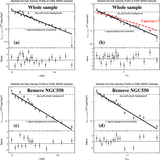Baryon Budget of the Hot Circumgalactic Medium of Massive Spiral Galaxies
Abstract
The baryon content around local galaxies is observed to be much less than is needed in Big Bang nucleosynthesis. Simulations indicate that a significant fraction of these “missing baryons” may be stored in a hot tenuous circumgalactic medium (CGM) around massive galaxies extending to or even beyond the virial radius of their dark matter halos. Previous observations in X-ray and Sunyaev-Zel’dovich (SZ) signals claimed that ∼(1-50)% of the expected baryons are stored in a hot CGM within the virial radius. The large scatter is mainly caused by the very uncertain extrapolation of the hot gas density profile based on the detection in a small radial range (typically within 10%-20% of the virial radius). Here, we report stacking X-ray observations of six local isolated massive spiral galaxies from the CGM-MASS sample. We find that the mean density profile can be characterized by a single power law out to a galactocentric radius of ≈200 kpc (or ≈130 kpc above the 1σ background uncertainty), about half the virial radius of the dark matter halo. We can now estimate that the hot CGM within the virial radius accounts for (8 ± 4)% of the baryonic mass expected for the halos. Including the stars, the baryon fraction is (27 ± 16)%, or (39 ± 20)% by assuming a flattened density profile at r ≳ 130 kpc. We conclude that the hot baryons within the virial radius of massive galaxy halos are insufficient to explain the “missing baryons.”
- Publication:
-
The Astrophysical Journal
- Pub Date:
- March 2018
- DOI:
- 10.3847/2041-8213/aab2af
- arXiv:
- arXiv:1802.09453
- Bibcode:
- 2018ApJ...855L..24L
- Keywords:
-
- intergalactic medium;
- galaxies: evolution;
- galaxies: fundamental parameters;
- galaxies: halos;
- galaxies: spiral;
- X-rays: galaxies;
- Astrophysics - Astrophysics of Galaxies;
- Astrophysics - Cosmology and Nongalactic Astrophysics;
- Astrophysics - High Energy Astrophysical Phenomena
- E-Print:
- 7 pages, 4 figures, 1 table, accepted for publication by ApJL
